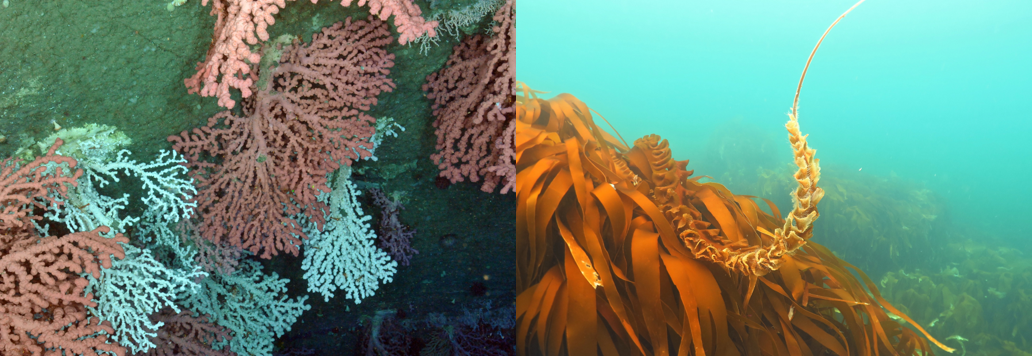Ecological connectivity of marine benthic invertebrates
Ecological connectivity refers to the exchange of individuals among habitats, populations, communities and ecosystems. For sessile invertebrates, connectivity is mainly achieved through larval dispersal, a process very challenging to measure. We focus on the early-life history processes that determine connectivity, such as larval development and survival, dispersal, settlement and post-settlement mortality. We investigate the role of environmental factors such as temperature, salinity, and flow as well as biological factors such as individual behaviour, food availability and predation on these processes using a combination of experiments in the laboratory, field sampling and mathematical modelling. We target ecologically important species from rocky subtidal and deep-sea ecosystems in temperate regions and the tropics.
Cumulative effects of marine invasives and climate warming on benthic ecosystems
In the northwest Atlantic, kelps beds have experienced a sharp decline over the last decade in our region and are being replaced by macroalgal turfs, mainly due to population outbreaks of the invasive bryozoan Membranipora membranacea. Additionally, sea water temperature has been increasing faster than average in our region, with direct negative effects on kelp survival and indirect positive effects on bryozoan population growth. Using experimental manipulations in the laboratory and in the field, in combination with field sampling using SCUBA along the Atlantic coast of Nova Scotia and mathematical modelling, my students and I are attempting to understand the mechanisms that determine the successful establishment, population growth and northward range expansion of the invasive and the implications for the persistence of native kelp in the face of climate warming.
Ecology of deep-water coral ecosystems
Deep-water corals provide structural complexity in the otherwise topographically homogeneous seafloor of the deep-sea, are long-lived and have slow population growth. They also provide habitat for attachment, nursing and foraging to other invertebrates, such as crustaceans and echinoderms, and fish. Our studies focus on the distribution of deep-water corals and the megafauna that are associated with these ecosystems along the continental slope on the northwest Atlantic Ocean. Using modelling approaches, we attempt to understand factors that regulate spatial patterns and predict areas of potentially suitable habitat, as well as patterns in hydrodynamic connectivity.
Marine Protected Areas and Marine Conservation
Area-based management tools, such as marine protected areas, are one of the main strategies used to protect marine biodiversity. Countries, including Canada, are racing to meet their Aichi target 11 obligation to conserve at least 10% of their coastal and marine areas by 2020 through the establishment of marine protected areas. We have been working with Fisheries & Oceans Canada to help them meet this target in two ways. We provide data that can be used to identify potential areas of conservation (e.g. http://www.dfo-mpo.gc.ca/oceans/publications/backgrounder-fiche/corsair-georges-jordan/index-eng.html), evaluate the performance of existing conservation areas (e.g. http://www.dfo-mpo.gc.ca/oceans/oeabcm-amcepz/refuges/northeast-nordest-eng.html) and inform the process of establishing conservation areas (e.g. http://www.dfo-mpo.gc.ca/oceans/aoi-si/easternshore-ilescoteest-eng.html). We also provide advice through consultations on the design of the Canada’s networks of marine protected areas, including on the importance of representation and connectivity in achieving conservation outcomes. Internationally, I have been working with the Deep-Ocean Stewardship initiative (http://dosi-project.org/) to provide expertise for the development of a deep-sea mining code by the International Seabed Authority that ensures effective protection of the marine environment, and the UN Intergovernmental Conference on Marine Biodiversity of Areas Beyond National Jurisdiction.
Financial Support





